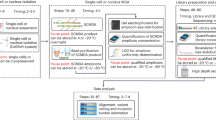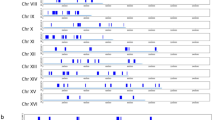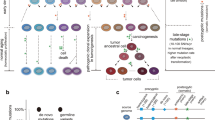Abstract
Cancer cells contain numerous clonal mutations. It has been theorized that malignant cells sustain an elevated mutation rate and, as a consequence, harbor yet larger numbers of random point mutations. Testing this hypothesis has been precluded by lack of an assay to measure random mutations—that is, mutations that occur in only one or a few cells of a population. We have established a method that has permitted us to detect and identify rare random mutations in human cells, at a frequency of 1 per 108 base pairs. The assay is based on gene capture, by hybridization with a uracil-containing probe, followed by magnetic separation. Mutations that render the mutational target sequence non-cleavable by a restriction enzyme are quantified by dilution to single molecules and real-time quantitative PCR amplification. The assay can be extended to quantify mutation in any DNA-based organism, at different sites in the genome, in introns and exons, in unselected and selected genes, and in proliferating and quiescent cells.
This is a preview of subscription content, access via your institution
Access options
Subscribe to this journal
Receive 12 print issues and online access
$259.00 per year
only $21.58 per issue
Buy this article
- Purchase on Springer Link
- Instant access to full article PDF
Prices may be subject to local taxes which are calculated during checkout





Similar content being viewed by others
References
Bielas, J.H. & Loeb, L.A. Mutator phenotype in cancer: timing and perspectives. Environ. Mol. Mutagen (in the press).
Jackson, A.L. & Loeb, L.A. The mutation rate and cancer. Genetics 148, 1483–1490 (1998).
Cervantes, R.B., Stringer, J.R., Shao, C., Tischfield, J.A. & Stambrook, P.J. Embryonic stem cells and somatic cells differ in mutation frequency and type. Proc. Natl. Acad. Sci. USA 99, 3586–3590 (2002).
Hanahan, D. & Weinberg, R.A. The hallmarks of cancer. Cell 100, 57–70 (2000).
Kallioniemi, A. et al. Comparative genomic hybridization for molecular cytogenetic analysis of solid tumors. Science 258, 818–821 (1992).
Bayani, J. et al. Parallel analysis of sporadic primary ovarian carcinomas by spectral karyotyping, comparative genomic hybridization, and expression microarrays. Cancer. Res. 62, 3466–3476 (2002).
Klein, C.A. et al. Comparative genomic hybridization, loss of heterozygosity, and DNA sequence analysis of single cells. Proc. Natl. Acad. Sci. USA 96, 4494–4499 (1999).
Wang, T.L. et al. Prevalence of somatic alterations in the colorectal cancer cell genome. Proc. Natl. Acad. Sci. USA 99, 3076–3080 (2002).
Futreal, P.A. et al. A census of human cancer genes. Nat. Rev. Cancer 4, 117–183 (2004).
Loeb, L.A., Springgate, C.F. & Battula, N. Errors in DNA replication as a basis of malignant change. Cancer Res. 34, 2311–2321 (1974).
Loeb, L.A., Loeb, K.R. & Anderson, J.P. Multiple mutations and cancer. Proc. Natl. Acad. Sci. USA 100, 776–781 (2003).
Patel, P.H. & Loeb, L.A. Multiple amino acid substitutions allow DNA polymerases to synthesize RNA. J. Biol. Chem. 275, 40266–40272 (2000).
Bielas, J.H. & Heddle, J.A. Elevated mutagenesis and decreased DNA repair at a transgene are associated with proliferation but not apoptosis in p53-deficient cells. Proc. Natl. Acad. Sci. USA 100, 12853–12858 (2003).
Mientjes, E.J. et al. DNA adducts, mutant frequencies, and mutation spectra in various organs of lambda lacZ mice exposed to ethylating agents. Environ. Mol. Mutagen. 31, 18–31 (1998).
Masumura, K. et al. Spectra of gpt mutations in ethylnitrosourea-treated and untreated transgenic mice. Environ. Mol. Mutagen. 34, 1–8 (1999).
Graw, J., Pretsch, W. & Loster, J. Mutation in intron 6 of the hamster Mitf gene leads to skipping of the subsequent exon and creates a novel animal model for the human Waardenburg syndrome type II. Genetics 164, 1035–1041 (2003).
Rouer, E., Brule, F. & Benarous, R. A single base mutation in the 5′ splice site of intron 7 of the lck gene is responsible for the deletion of exon 7 in lck mRNA of the JCaM1 cell line. Oncogene 18, 4262–4268 (1999).
Bielas, J.H. & Heddle, J.A. Quiescent murine cells lack global genomic repair but are proficient in transcription-coupled repair. DNA Repair (Amst.) 3, 711–717 (2004).
Bielas, J.H. & Heddle, J.A. Proliferation is necessary for both repair and mutation in transgenic mouse cells. Proc. Natl. Acad. Sci. USA 97, 11391–11396 (2000).
Parsons, B.L. & Heflich, R.H. Genotypic selection methods for the direct analysis of point mutations. Mutat. Res. 387, 97–121 (1997).
Parry, J.M., Shamsher, M. & Skibinski, D.O. Restriction site mutation analysis, a proposed methodology for the detection and study of DNA base changes following mutagen exposure. Mutagenesis 5, 209–212 (1990).
Steingrimsdottir, H. et al. Development of new molecular procedures for the detection of genetic alterations in man. Mutat. Res. 353, 109–121 (1996).
Jenkins, G.J., Suzen, H.S., Sueiro, R.A. & Parry, J.M. The restriction site mutation assay: a review of the methodology development and the current status of the technique. Mutagenesis 14, 439–448 (1999).
Hussain, S.P. et al. Increased p53 mutation load in noncancerous colon tissue from ulcerative colitis: a cancer-prone chronic inflammatory disease. Cancer Res. 60, 3333–3337 (2000).
Pourzand, C. & Cerutti, P. Genotypic mutation analysis by RFLP/PCR. Mutat. Res. 288, 113–121 (1993).
Pourzand, C. & Cerutti, P. Mutagenesis of H-ras codons 11 and 12 in human fibroblasts by N-ethyl-N-nitrosourea. Carcinogenesis 14, 2193–2196 (1993).
Makalowski, W. The human genome structure and organization. Acta Biochim. Pol. 48, 587–598 (2001).
Lindahl, T. & Wood, R.D. Quality control by DNA repair. Science 286, 1897–1905 (1999).
Santos, J.H., Meyer, J.N., Skorvaga, M., Annab, L.A. & Van Houten, B. Mitochondrial hTERT exacerbates free radical–mediated mtDNA damage. Aging Cell 3, 399–411 (2004).
Loeb, L.A., Preston, B.D., Snow, E.T. & Schaaper, R.M. Apurinic sites as common intermediates in mutagenesis. Basic Life Sci. 38, 341–347 (1986).
Acknowledgements
The authors thank A. Blank for insightful comments and critical reading of the manuscript, E. Glick and C. Heindel for advice, and N. Griner for excellent technical assistance. This work was funded by grants CA78885 and CA102029 from the US National Institutes of Health. J.H.B. is supported by a postdoctoral fellowship from the Natural Sciences and Engineering Research Council of Canada.
Author information
Authors and Affiliations
Corresponding author
Ethics declarations
Competing interests
The authors declare no competing financial interests.
Rights and permissions
About this article
Cite this article
Bielas, J., Loeb, L. Quantification of random genomic mutations. Nat Methods 2, 285–290 (2005). https://doi.org/10.1038/nmeth751
Received:
Accepted:
Published:
Issue Date:
DOI: https://doi.org/10.1038/nmeth751
This article is cited by
-
Evolutionary conservation of the fidelity of transcription
Nature Communications (2023)
-
Detection of low-frequency mutations in clinical samples by increasing mutation abundance via the excision of wild-type sequences
Nature Biomedical Engineering (2023)
-
Mutant allele quantification reveals a genetic basis for TP53 mutation-driven castration resistance in prostate cancer cells
Scientific Reports (2018)
-
The influence of subclonal resistance mutations on targeted cancer therapy
Nature Reviews Clinical Oncology (2016)
-
Chromosomal instability and transcriptome dynamics in cancer
Cancer and Metastasis Reviews (2013)



